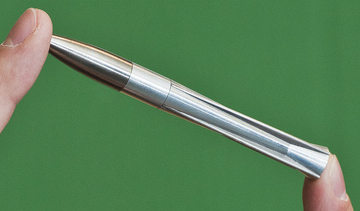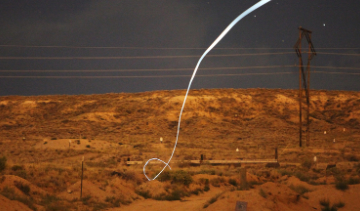
Self-guided bullet can hit target a mile away
Mike McLeod
Motion Control Defense actuator sensorEquiped with a nose sensor, actuator and fins, Sandia Labs’ small-caliber prototype seeks and finds laser-painted target.
 Engineering researchers, Red Jones and Brian Kast, at Sandia National Laboratories have patented a design for a dart-like, self-guided bullet for small-caliber, smooth-bore firearms that could hit laser-designated targets at distances of more than a mile (about 2,000 meters).
Engineering researchers, Red Jones and Brian Kast, at Sandia National Laboratories have patented a design for a dart-like, self-guided bullet for small-caliber, smooth-bore firearms that could hit laser-designated targets at distances of more than a mile (about 2,000 meters).
The four-inch-long bullet includes an optical sensor in the nose to detect a laser beam on a target. The sensor sends information to guidance and control electronics that use an algorithm in an eight-bit central processing unit to command electromagnetic actuators. These actuators then steer tiny fins that guide the bullet to the target.
To allow the Sandia bullet to turn in flight, conventional rifle barrel grooves (i.e. rifling) — and the spin they impart — had to be eliminated in favor of a smooth-bore barrel. In addition, the Sandia bullet’s design is akin to a dart with its center of gravity shifted forward and fins for aerodynamic stability. Plastic sabots provide a gas seal in the cartridge and protect the delicate fins until they drop off after the bullet emerges from the firearm’s barrel.
The prototype does not require an inertial measuring unit, a device found in much larger guided missiles. Instead, the researchers found that the bullet’s relatively small size when compared to guided missiles “is helping us all around. It’s kind of a fortuitous thing that none of us saw when we started,” Jones said.
As the bullet flies through the air, it pitches and yaws at a set rate based on its mass and size. In larger guided missiles, the rate of flight-path corrections is relatively slow, so each correction needs to be very precise because fewer corrections are possible during flight. But “the natural body frequency of this bullet is about 30 hertz, so we can make corrections 30 times per second. That means we can overcorrect, so we don’t have to be as precise each time,” Jones said.

A tiny light-emitting diode, or LED, attached to a self-guided bullet at Sandia National Laboratories shows a bright path during a nighttime field test that proved the battery and electronics could survive the bullet's launch. (Photo courtesy of Sandia National Laboratories)
Physical testing has shown the electromagnetic actuator performs well and the bullet can reach speeds of 2,400 feet per second, or Mach 2.1, using commercially available gunpowder. The researchers say it could reach standard military speeds using customized gunpowder.
Researchers also filmed high-speed video of the bullet radically pitching as it exited the barrel. The bullet pitches less as it flies down range, a phenomenon known to long-range firearms experts as “going to sleep.” Because the bullet’s motions settle the longer it is in flight, accuracy improves at longer ranges, Jones said.
“Nobody had ever seen that, but we’ve got high-speed video photography that shows that it’s true,” he said.
Sandia is seeking a private company partner to complete testing of the prototype and bring a guided bullet to the marketplace. Potential customers for the bullet include the military, law enforcement and recreational shooters.
In addition to Jones and Kast, Sandia researchers who helped develop the technology are: engineer Brandon R. Rohrer, aerodynamics expert Marc W. Kniskern, mechanical designer Scott E. Rose, firearms expert James W. Woods and Ronald W. Greene, a guidance, control and simulation engineer.
www.sandia.gov
